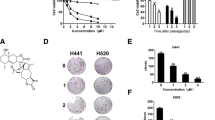Abstract
NF-kappaB pathway has been proven to be critical to survival of lung cancer cells, and many natural products from plants were shown to inhibit the activation of this pathway. In this study, we investigated the effects of two cardamonin analogs, 4,4′-dihydroxylchalcone (DHC) and 4,4′-dihydroxy-2′-methoxychalcone (DHMC), on survival of lung cancer cells and the involved mechanisms. MTT assay revealed that the two compounds potently decreased the survival of immortalized and primary lung cancer cells. DHC and DHMC were able to induce apoptosis in A549 and NCI-H460 cells. Immunoblotting, immunofluorescent staining, and luciferase reporter further demonstrated that the two compounds suppressed the activation of NF-kappaB pathway in lung cancer cells. PMA-mediated NF-kappaB reactivation abrogated the effect of DHC and DHMC on lung cancer cells. DHC and DHMC were also shown to suppress the growth of A549 xenograft in mice. Collectively, we verified two cardamonin analogs as novel compounds suppressing NF-kappaB signaling for lung cancer therapy.






Similar content being viewed by others
References
Egleston BL, Meireles SI, Flieder DB, Clapper ML (2009) Population-based trends in lung cancer incidence in women. Semin Oncol 36:506–515
Bates SE, Amiri-Kordestani L, Giaccone G (2012) Drug development: portals of discovery. Clin Cancer Res 18:23–32
Hanahan D, Weinberg RA (2000) The hallmarks of cancer. Cell 100:57–70
Denlinger CE, Rundall BK, Jones DR (2004) Modulation of antiapoptotic cell signaling pathways in non-small cell lung cancer: the role of NF-kappaB. Semin Thorac Cardiovasc Surg 16:28–39
Shen HM, Tergaonkar V (2009) NFkappaB signaling in carcinogenesis and as a potential molecular target for cancer therapy. Apoptosis 14:348–363
Aggarwal BB, Shishodia S, Sandur SK, Pandey MK, Sethi G (2006) Inflammation and cancer: how hot is the link? Biochem Pharmacol 72:1605–1621
Lin Y, Shi R, Wang X, Shen HM (2008) Luteolin, a flavonoid with potential for cancer prevention and therapy. Curr Cancer Drug Targets 8:634–646
Birt DF, Hendrich S, Wang W (2001) Dietary agents in cancer prevention: flavonoids and isoflavonoids. Pharmacol Ther 90:157–177
Saied S, Shah S, Ali Z, Khan A, Marasini BP, Choudhary MI (2011) Chemical constituents of Cichorium intybus and their inhibitory effects against urease and alpha-chymotrypsin enzymes. Nat Prod Commun 6:1117–1120
Zhou ZH, Wang JL, Yang CR (2001) Cochinchinenin: a new chalcone dimer from the Chinese dragon blood. Yao Xue Xue Bao 36:200–204
Tamatani M, Che YH, Matsuzaki H, Ogawa S, Okado H, Miyake S, Mizuno T, Tohyama M (1999) Tumor necrosis factor induces Bcl-2 and Bcl-x expression through NFkappaB activation in primary hippocampal neurons. J Biol Chem 274:8531–8538
Kawakami H, Tomita M, Matsuda T, Ohta T, Tanaka Y, Fujii M, Hatano M, Tokuhisa T, Mori N (2005) Transcriptional activation of survivin through the NF-kappaB pathway by human T-cell leukemia virus type I tax. Int J Cancer 115:967–974
Sandur SK, Ahn KS, Ichikawa H, Sethi G, Shishodia S, Newman RA, Aggarwal BB (2007) Zyflamend, a polyherbal preparation, inhibits invasion, suppresses osteoclastogenesis, and potentiates apoptosis through down-regulation of NF-kappa B activation and NF-kappa B-regulated gene products. Nutr Cancer 57:78–87
Ahn KS, Sethi G, Aggarwal BB (2007) Embelin, an inhibitor of X chromosome-linked inhibitor-of-apoptosis protein, blocks nuclear factor-kappaB (NF-kappaB) signaling pathway leading to suppression of NF-kappaB-regulated antiapoptotic and metastatic gene products. Mol Pharmacol 71:209–219
Lee KY, Park JS, Jee YK, Rosen GD (2002) Triptolide sensitizes lung cancer cells to TNF-related apoptosis-inducing ligand (TRAIL)-induced apoptosis by inhibition of NF-kappaB activation. Exp Mol Med 34:462–468
Hsu YL, Kuo PL, Lin CC (2004) Proliferative inhibition, cell-cycle dysregulation, and induction of apoptosis by ursolic acid in human non-small cell lung cancer A549 cells. Life Sci 75:2303–2316
Shaik AA, Hermanson DL, Xing C (2009) Identification of methysticin as a potent and non-toxic NF-kappaB inhibitor from kava, potentially responsible for kava’s chemopreventive activity. Bioorg Med Chem Lett 19:5732–5736
Woo JH, Li D, Wilsbach K, Orita H, Coulter J, Tully E, Kwon TK, Xu S, Gabrielson E (2007) Coix seed extract, a commonly used treatment for cancer in China, inhibits NFkappaB and protein kinase C signaling. Cancer Biol Ther 6:2005–2011
Saydam G, Aydin HH, Sahin F, Kucukoglu O, Erciyas E, Terzioglu E, Buyukkececi F, Omay SB (2003) Cytotoxic and inhibitory effects of 4,4′-dihydroxy chalcone (RVC-588) on proliferation of human leukemic HL-60 cells. Leuk Res 27:57–64
Post JF, Varma RS (1992) Growth inhibitory effects of bioflavonoids and related compounds on human leukemic CEM-C1 and CEM-C7 cells. Cancer Lett 67:207–213
Hayden MS, Ghosh S (2004) Signaling to NF-kappaB. Genes Dev 18:2195–2224
Sun YW, Huang WJ, Hsiao CJ, Chen YC, Lu PH, Guh JH (2010) Methoxychalcone induces cell-cycle arrest and apoptosis in human hormone-resistant prostate cancer cells through PI 3-kinase-independent inhibition of mTOR pathways. Prostate 70:1295–1306
Orlikova B, Tasdemir D, Golais F, Dicato M, Diederich M (2011) The aromatic ketone 4′-hydroxychalcone inhibits TNFalpha-induced NF-kappaB activation via proteasome inhibition. Biochem Pharmacol 82:620–631
Nam NH, Kim Y, You YJ, Hong DH, Kim HM, Ahn BZ (2003) Cytotoxic 2′,5′-dihydroxychalcones with unexpected antiangiogenic activity. Eur J Med Chem 38:179–187
Srinivasan B, Johnson TE, Lad R, Xing C (2009) Structure-activity relationship studies of chalcone leading to 3-hydroxy-4,3′,4′,5′-tetramethoxychalcone and its analogues as potent nuclear factor kappaB inhibitors and their anticancer activities. J Med Chem 52:7228–7235
Author information
Authors and Affiliations
Corresponding authors
Rights and permissions
About this article
Cite this article
He, W., Jiang, Y., Zhang, X. et al. Anticancer cardamonin analogs suppress the activation of NF-kappaB pathway in lung cancer cells. Mol Cell Biochem 389, 25–33 (2014). https://doi.org/10.1007/s11010-013-1923-0
Received:
Accepted:
Published:
Issue Date:
DOI: https://doi.org/10.1007/s11010-013-1923-0




